Remote Web Development
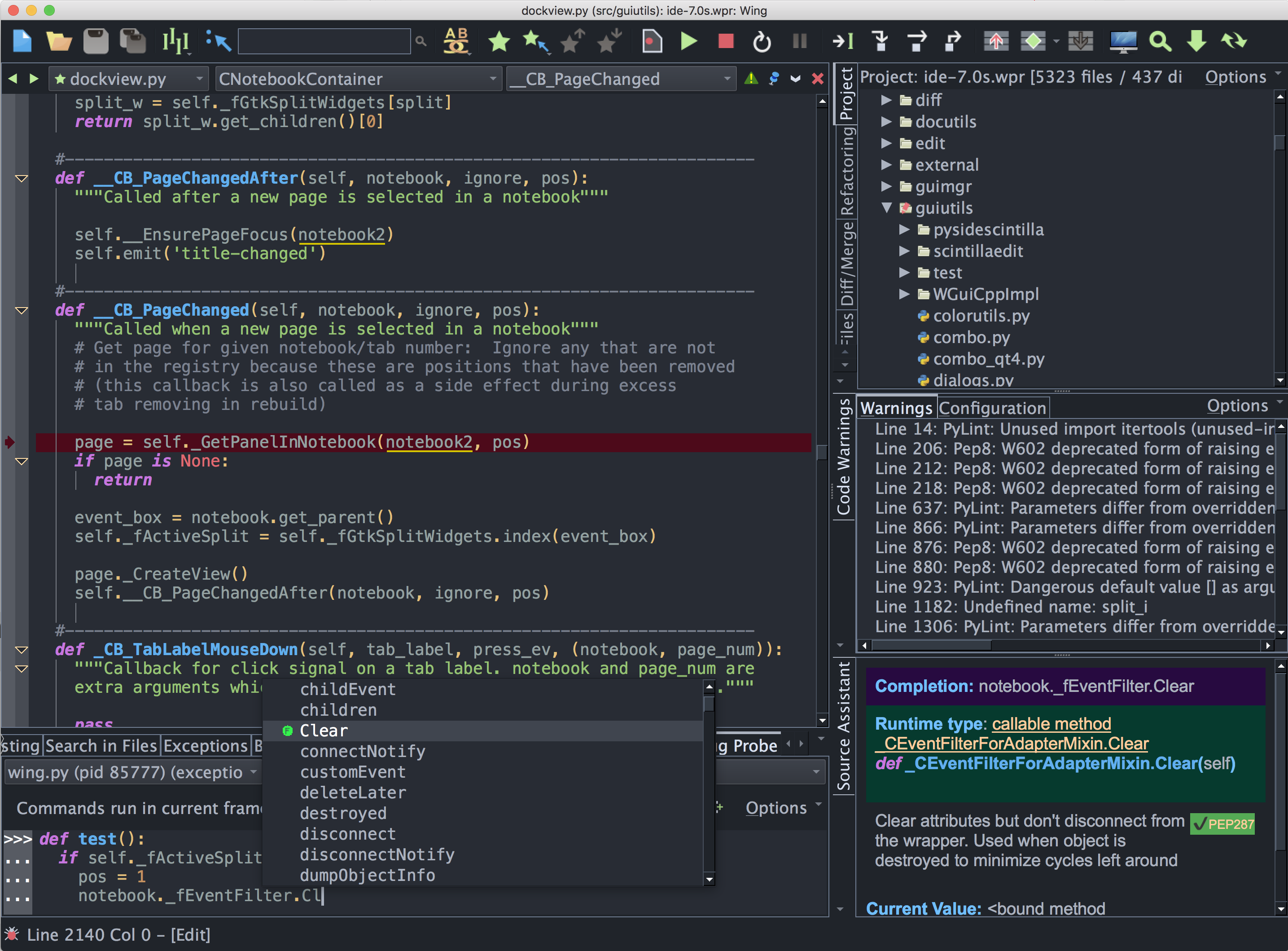
Wing Pro is a Python IDE that can be used to develop, test, and debug websites running on a remote server, VM, or other system where an IDE cannot be installed. Debugging takes place in the context of the web server or web framework, as code is invoked by browser page load. Wing provides auto-completion, call tips, find uses, and many other features that help you work with Python code.
If you do not already have Wing Pro installed, download it now.
This document focuses on how to configure Wing for remote web development. To get started using Wing as your Python IDE, please refer to the tutorial in Wing's Help menu or read the Quickstart Guide.
Setting up SSH Access
Wing Pro's remote development support assumes that you have already set access to the remote host with SSH. This can be tested outside of Wing using ssh or PuTTY, or you can use Wing's built-in SSH implementation. See Setting up SSH for Remote Development for a detailed description of the available configuration options. However, in most cases all you will need to know is the user name and the ip address or host name of the remote system.
Installing the Remote Agent
The next step is to set up a remote host configuration from Remote Hosts in the Project menu. Press the + icon to add a new remote host configuration.
You will need to choose a short identifier that Wing will use to refer to the host and enter the hostname, which may be a name or an IP address and can be in username@hostname form if the remote user name does not match the local one. You will only rarely need to specify any of the other values in a remote host configuration. For now, leave them blank. For example:
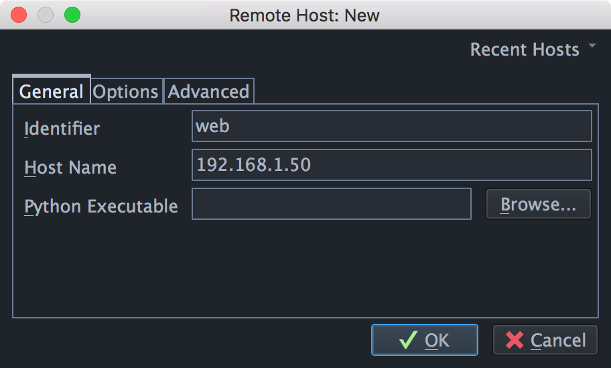
Once you submit the dialog for creating the configuration, Wing will try to probe the remote host and then install the appropriate remote agent. When the process completes it should confirm that the remote agent is installed and working as follows:
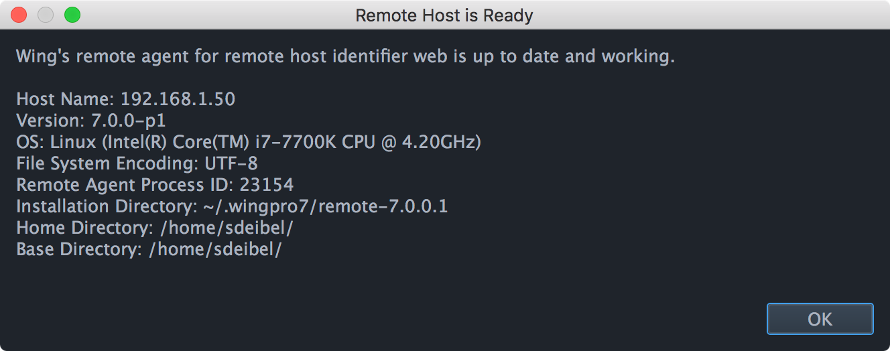
Next return to the Remote Hosts dialog and specify that the remote host configuration you've just created should be shared, so that it isn't just stored in the currently open project:
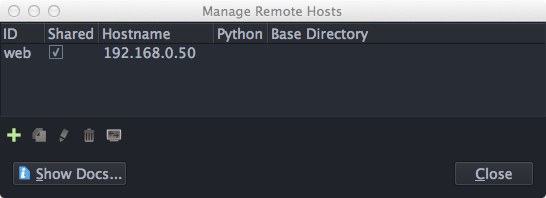
If something goes wrong during the remote agent installation process, Wing will instead show a dialog similar to the following:
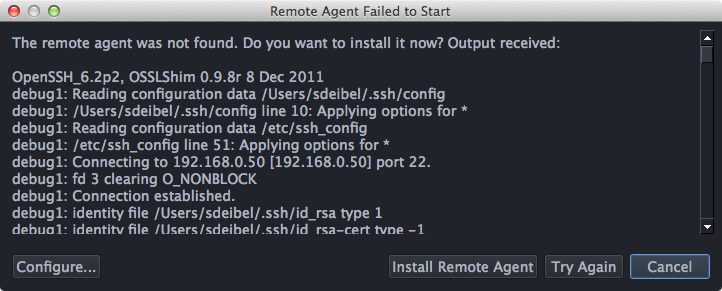
In this case, the output provided may help to diagnose and fix the problem. Or, for help contact support@wingware.com.
Setting up a Project
Now it's time to set up a project that accesses your files on the remote host. To do this, select New Project in the Project menu, use the Create Blank Project option, and then press Create Project.
You can also set up a remote host from the New Project dialog, but let's use the blank project type now so that you will see where the relevant configuration takes place.
Click OK to create the project, and then go into Project Properties from the Project menu. Set the Python Executable to Remote and select the remote host you've just configured:

Next add your files to the project with the Add Existing Directory item in the Project menu. Press the Browse button next to the Directory field to display a dialog that browses the file system on the remote host. Go into the directory you want to add and press Select Directory.
Wing will spend some time scanning the disk and analyzing files but you should already be able to open and edit source files stored on the remote host from the Project tool.
Initiating Debug
This How-To assumes you're going to be launching your web server or web framework from outside of Wing and want to debug-enable code that is invoked as you browse your development website. The way Wing does this is by providing a module wingdbstub.py that you can import to initiate debug.
When you installed the remote agent above, Wing wrote a preconfigured copy of wingdbstub.py to the remote agent installation directory. By default this is ~/.wingpro11/remote-11.0.6.0/wingdbstub.py where ~ indicates the remote user's home directory. This will vary if you change the Installation Directory under the Advanced tab of your remote host configuration (which is not recommended).
Copy that file to the same directory as your code and add the following to your code before it reaches anything you'll want to debug:
import wingdbstub
Next tell Wing to listen for connections from an externally launched debug process. This is done by clicking on the bug icon in the lower left of Wing's window and checking on Accept Debug Connections:
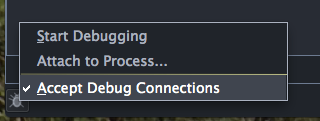
If you hover over the bug icon, Wing shows that it is listening for connections, both on the local host and on the configured remote host:

Note: If you are using Apache or otherwise run your code as a user that is different from the one used in your remote host configuration, you'll need to adjust permissions on some files as described in the section Managing Permissions below.
Debugging Code
Now you can set some breakpoints by clicking on the breakpoint margin to the left of your code. For example:

Once this is done you should be able to point your browser at a web page that executes code with a breakpoint, and Wing should stop on it:

Use Stack Data to view debug data:
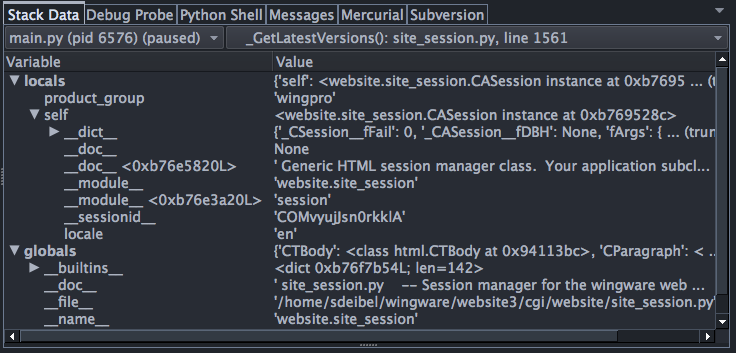
Or just interact on the command line within the current stack frame in the Debug Console tool:
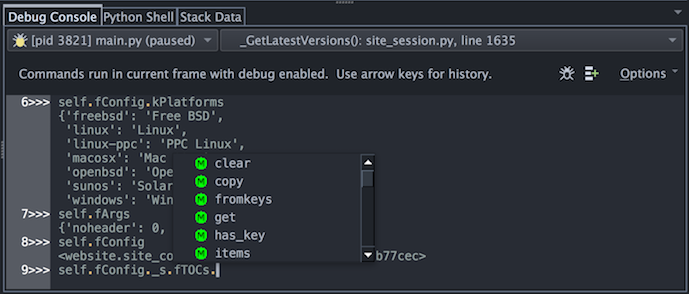
Both of these tools are accessible from Wing's Tools menu.
This technique should work with any web development framework. See Web Development How-Tos for details on using Wing with specific frameworks.
Managing Permissions
If your code is running as a different user than the one specified in your remote host configuration, as may be the case if running under Apache or another web server, then you will need to make some additional changes to make remote debugging work. For example, your remote host configuration may set Host Name to devel@192.168.0.50 so the user that installs the remote agent is devel while the code is actually run by the user apache.
In this case you must change the disk permissions on the Install Dir from which you copied wingdbstub.py so it can be read by the user that runs your debug process. The best way to do this is to create a group that includes both users and use that group for the directory, for example with chgrp -R groupname dirname.
Then change your copy of wingdbstub.py by replacing ~ with the full path to the home directory of the user in the remote host configuration. This is needed because ~ will expand to a different directory if the code is run as a different user.
You may also want to change the permissions on the debugger security token file wingdebugpw so that both users can read it, for example with chmod 640 wingdebugpw. The default for this file is to allow only the owner to read it. If this isn't done, Wing will generate a different debugger security token on the remote host and will initially reject your debug connection and prompt for you to accept the new security token. Once that is done, future debug connections will be accepted.
Resources
- Web Development How-Tos contains instructions for using Wing with specific web development frameworks, such as Django, Flask, Pyramid, web2py, and others.
- Remote Hosts documentation provides details for configuring Wing Pro to work with remote hosts.
- Quick Start provides an introduction to Wing's features.
- Tutorial takes you through Wing's features step by step.
- Wing Reference Manual documents Wing in detail.


